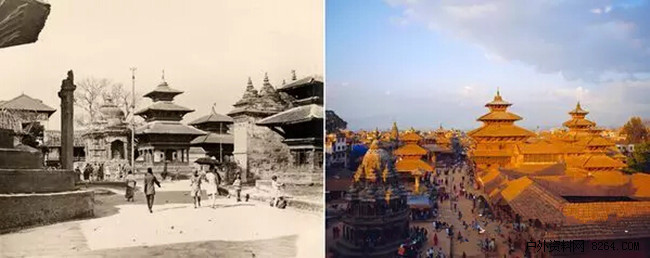From the 1920s, people wearing reindeer leather boots with rusted steel crampons for the first time ever climbed Mount Everest. The world has undergone great changes.

Here is a comparison of the equipment when climbing the Everest in the early century and in 2012:
Altimeters 1924 vs. 2012

In 1924, Pioneer climber George Mallory died in the icy snow-capped mountains. In 1999, Conrad Anker's expedition discovered his body and elevation table at Mount Everest. The Everest historian had hoped that the antique equipment could show the altitude he reached at that time, but the mystery could not be solved due to the weathering of the altitude meter. Today's Trimble GeoXH 6000 is a handheld GPS designed for harsh environments and used for high-precision mapping navigation. Built-in Windows phone operating system and a camera.
Boots 1963 vs. 2012

The old reindeer boots are still attractive on their exterior, but climbing has become a high-tech adventure. Putting on this heavy, slow-drying boot with both hands with thick gloves is one of many challenges. Today's Alpine Boots design includes foam insulation, fast drying with removable liners, heat-reflective aluminum liners that are exceptionally warm, and durable front zippers.
Thermal Coats 1963 vs. 2012

In 1963, the climbers wore Parka windbreakers and in 2012 they wore jumpsuits specifically designed to climb the 8,000-meter extreme weather.
Oxygen System 1953 vs. 2012

In 1953, the Everest expedition in the UK carried a closed-circuit oxygen system weighing 35 pounds (about 16 kilograms). In 2012, the world’s lightest aluminum oxygen bottle was 5.5 lbs (2.5 kg) – 7.6 lbs (3.4 kg), depending on whether the charge was 3 liters or 4 liters.
Cameras 1921 vs. 2012

Alexander Kellers, an early Himalayan explorer, used this pocket camera to photograph his unfinished Mount Everest adventure in 1921. He died of diarrhea and heart failure on the way to the mountains. The Canon 5D Mark II features a digital camera, including a camera, for the 2012 National Geographic magazine Everest Expedition.
Backpacks 1963 vs. 2012

The old, heavy aluminum frame is firmly fixed to the back, and now is a built-in frame that is lightweight, increases storage space, and makes climbing more freely.
Ice Ax 1963 vs. 2012

The difference between the 1963 Everest expedition and the Black Diamond used in 2012 can be summed up in one word: design. The current tool is an ultra-light aluminum alloy, an ergonomic stainless steel head, and a round hole with a hanging iron lock. The old-fashioned steel handles with ice axes are heavier.
Sleeping Bags 1963 vs. 2012

North Face Sleeping Bag 800+ fluffiness used in 2012, East European goose down padding
Climashield Prism Long Fiber, Close Compression Pad
Trapezoidal three-dimensional sealing type joint structure, side bag partition
External fabric wear-resistant, lightweight, waterproof, breathable
Ergonomically designed arched warehouse
Crampons 1743 vs. 2012

The old crampons are steel, heavy and easy to rust. The new crampons are made of stainless steel, do not rust and do not catch snow.
ClimbingRope 1963 vs. 2012

In 1963, the rope was made of plant fibres (hemp or jute) and was very heavy; now it uses a flexible nylon rope that is durable, lightweight and smooth.
Ladders (Ladder) 1963 vs. 2012

In 1963, the American expedition led by Norman Dyhrenfurth used cracks in logs to cross ice; in 2012, the team used lightweight aluminium ladders for easy transportation and safe passage.
Record Keeping (record) 1956 vs. 2012

The 1956 Fritz Müller expedition recorded manually; in 2012, the weather was checked on a laptop.
Inside the Tent 1903 vs. 2012

In 1953, the team members crowded into tents and listened to the Queen's coronation ceremony on the radio. In 2012, the communication tent had Wi-Fi and a series of communication facilities.
Himalayan Schools (1956) vs. 2012

In 1953 Edmond Hillary and Tenzing Norgay became the first climbers to reach the peak of Mount Everest. Shortly afterwards, Hillary founded the Himalayan trust fund and established schools and hospitals. In 1966 students used rough wooden pencils and red sand to write.
Tourist Destination Intact 1924 vs. 2012

The Everest adventure that began in the last century has undergone fundamental changes in equipment and technology. However, Kathmandu’s Durbar Square and Visitor Center still retains its historic atmosphere and spectacular architecture, including a royal palace dating back to the 11th century. .
Unfortunately, in the April 2015 earthquake, once the Durbar Square was “wounded,†it was completely different.

Pdt Led Light Therapy,Therapy Mask Machine Device,Pdt Machine ,Led Light Facial Therapy
Shenzhen Bonliter Optoelectronic Co., Ltd. , https://www.beautyredlight.com